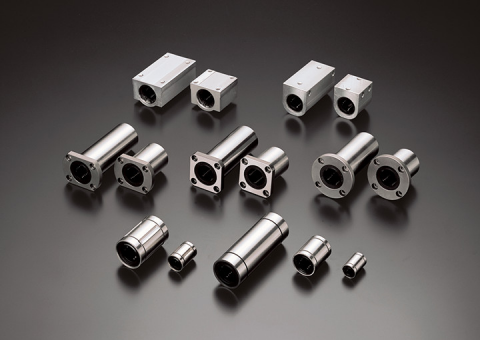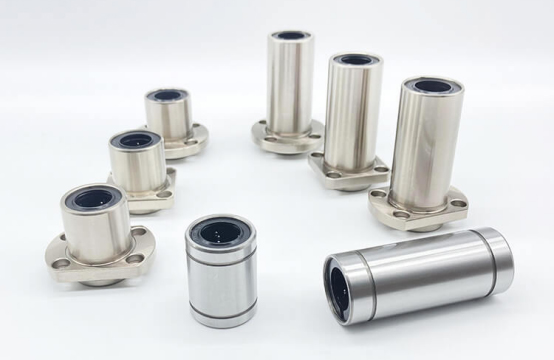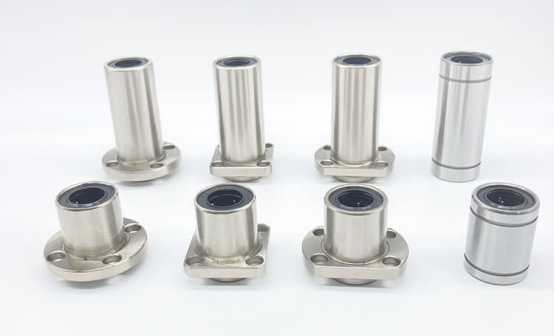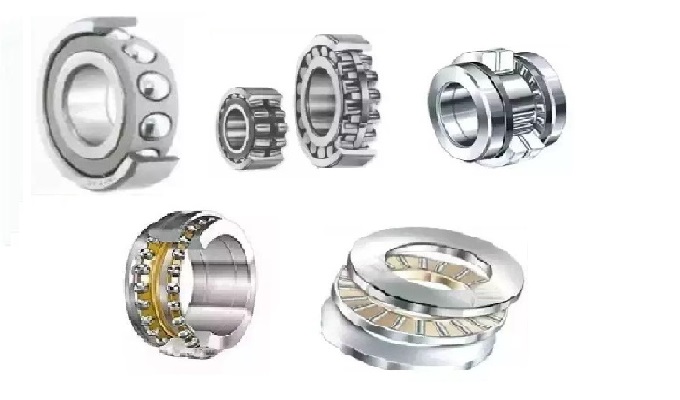Introduction
Linear bearings are mechanical components that provide linear motion with minimal friction and high precision. They are used in various industrial applications, including manufacturing machinery, automation equipment, medical devices, and robotics. Linear bearings come in different types, sizes, and materials, each with unique advantages and applications.
The importance of linear bearings in various applications cannot be overstated. In manufacturing, for example, linear bearings support and guide machine tool components, such as cutting heads and drill bits, ensuring accurate and precise movement. In automation, linear bearings provide smooth and precise movement of robotic arms and conveyors, increasing productivity and efficiency. In medical devices, linear bearings ensure precise movement of surgical instruments and imaging equipment, improving the quality and safety of medical procedures.
Overall, the performance and reliability of machines and equipment depend on the quality and selection of linear bearings. Choosing the right type of linear bearing for a specific application can improve the system's efficiency, productivity, and quality.
Types of Linear Bearings
Several types of linear bearings are available, and the most common ones include ball bearings, roller bearings, plain bearings, and sleeve bearings. Each of these types has its unique characteristics and applications.
●Ball Bearings:
Ball bearings are the most commonly used type of linear bearings. They consist of balls that roll between two surfaces, allowing smooth and low-friction linear motion. Ball bearings are highly accurate and efficient and can handle high speeds and loads. They are commonly used in applications that require high precision, such as machine tools, robotics, and automation equipment.
●Roller Bearings:
Roller bearings are similar to ball bearings, but instead of balls, they use rollers to provide linear motion. Roller bearings can handle heavier loads and are ideal for applications that require high load capacity and low friction. They are commonly used in conveyor systems, material handling equipment, and heavy machinery.
●Plain Bearings:
Plain bearings, also known as bushings, are a simple type of linear bearings that use a sliding motion to provide linear motion. They consist of a sleeve that slides along a shaft or rail and can be made from various materials such as metal, plastic, or composite. Plain bearings are easy to install, low-cost, and require minimal maintenance. They are commonly used in low-load, low-speed applications such as packaging machinery and small automation systems.
●Sleeve Bearings:
Sleeve bearings are similar to plain bearings but have a self-lubricating feature. They are composed of a sleeve made of a low-friction material such as graphite or plastic impregnated with oil. Sleeve bearings are easy to install and require minimal maintenance, making them ideal for demanding applications to access or maintain. They are commonly used in fans, motors, and other rotating equipment.
In summary, the type of linear bearing used depends on the application and specific system requirements. Ball and roller bearings are ideal for high-speed and high-load applications, while plain and sleeve bearings are better suited for low-speed and low-load applications.

Construction of Linear Bearings
Linear bearings are constructed using several components to provide smooth and precise linear motion. The main components of a linear bearing include:
◆Outer Rail:
The outer rail is a long, straight piece of material that provides a surface for the inner carriage or slide block to move along. The outer rail can be made from various materials such as aluminium, steel, or stainless steel and is often designed to be rigid and durable.
◆Inner Carriage or Slide Block:
The inner carriage or slide block is the component that moves along the outer rail and is connected to the load being moved. The inner carriage or slide block can be made from various materials such as plastic, steel, or aluminium and is designed to be low friction, wear-resistant, and lightweight.
◆Bearing Elements:
The bearing elements are the components that provide the low-friction contact between the inner carriage or slide block and the outer rail. These can be balls, rollers, or sliding surfaces such as PTFE or graphite. The choice of bearing elements depends on the application's specific requirements and the load capacity needed.
The materials used in constructing linear bearings are selected based on their properties, such as strength, wear resistance, and friction coefficient. For example, steel is often used for the outer rail due to its high strength and durability. In contrast, plastics are commonly used for the inner carriage or slide block because of their low friction coefficient and resistance to wear.
Several factors must be considered when designing a linear bearing, such as load capacity, travel distance, and operating conditions. These factors influence the selection of materials, the size of the bearing elements, and the design of the outer rail and inner carriage or slide block.
In summary, constructing linear bearings is critical to their durability, reliability, and performance. The selection of materials and design considerations can influence the load capacity, friction, wear resistance, and overall efficiency of the linear bearing.

Load Capacity of Linear Bearing
Load capacity is a critical factor when selecting a linear bearing as it directly influences its ability to support a load without premature wear or failure. Several factors affect load capacity, including:
●Bearing Size:
Larger bearings typically have a higher load capacity than smaller ones because they have more bearing elements and a larger surface area to distribute the load.
●Type of Bearing Element:
The bearing element used in a linear bearing affects its load capacity. For example, roller bearings generally have a higher load capacity than ball bearings due to the increased contact area.
●Lubrication:
Proper lubrication is crucial for reducing friction and preventing premature wear or failure. Lubrication also helps to distribute the load evenly across the bearing elements, increasing the bearing's load capacity.
●Operating Conditions:
The operating conditions, such as temperature, speed, and environmental factors, can affect a bearing's load capacity. For example, high temperatures can cause lubricants to break down, reducing the bearing's load capacity.
Different types of linear bearings have different load capacities. Ball bearings have a lower load capacity than roller bearings due to their smaller contact area. Plain bearings typically have a higher load capacity than ball bearings but lower than roller bearings. Sleeve bearings are usually used for lighter loads.
If needed to calculate load capacity, several factors must be considered, including the type of load, operating conditions, and bearing size. The load capacity can be calculated using various formulas and guidelines by bearing manufacturers.
In summary, load capacity is critical when selecting a linear bearing. The bearing's size, bearing element, lubrication, and operating conditions can all affect load capacity. Choosing a bearing with a load capacity that meets the application's requirements is essential to ensure durability and reliability.
Lubrication in Linear Bearing
Proper lubrication is essential for reducing friction, preventing wear, and extending the service life of linear bearings. Without adequate lubrication, bearings can overheat, seize, and fail prematurely. Different types of lubricants, such as oil and grease, are used depending on the application and type of bearing.
Oil lubrication is suitable for high-speed applications where the bearing's temperature must be kept low. The oil is delivered to the bearing through a lubrication system, which can be centralized or decentralized. Centralized systems involve a single oil source that supplies multiple bearings, while decentralized systems have individual oil sources for each bearing. Oil lubrication provides better cooling and higher lubricity compared to grease.
Grease lubrication is suitable for low to medium-speed applications with a risk of contamination or loss of lubricant. The grease is delivered to the bearing through a grease fitting or nipple. It consists of base oil, thickener, and additives that improve its properties, such as viscosity and temperature resistance. Grease lubrication offers better sealing and protection against contamination compared to oil.
Proper lubrication methods include continuous, intermittent, and manual lubrication. Continuous lubrication involves supplying a constant flow of oil or grease to the bearing, usually through a centralized system. Intermittent lubrication involves regular oil or grease supply, and manual lubrication involves applying lubricant directly to the bearing using a grease gun or oiler.
In summary, proper lubrication is essential for reducing friction, preventing wear, and extending the service life of linear bearings. Different types of lubricants, such as oil and grease, are used depending on the application and type of bearing. Depending on the application's requirements, the lubrication method can be continuous, intermittent, or manual. It's essential to follow the manufacturer's lubrication recommendations to ensure optimal bearing performance and longevity.
Mounting of Linear Bearings
Mounting is a critical aspect of linear bearing installation. The method used depends on the application and type of bearing. Different mounting methods include bolt-on, press-fit, and adhesive bonding.
Bolt-on mounting involves attaching the bearing to a structure using bolts or screws. This method is suitable for applications with high loads and requires easy removal or adjustment. Bolt-on mounting allows for easy replacement and maintenance of the bearing.
Press-fit mounting involves pressing the bearing into a housing or structure with a specified interference fit. This method provides a secure fit and can withstand high loads. Press-fit mounting is commonly used for linear bearings with an outer cylindrical surface, such as sleeve and plain bearings.
Adhesive bonding involves applying a suitable adhesive to the bearing and the mating surface to create a strong bond. This method provides a secure fit and can withstand high loads. Adhesive bonding is suitable for applications where welding or mechanical fastening is not feasible or desirable.
Factors to consider when choosing a mounting method include load capacity, accuracy requirements, environmental conditions, and accessibility for maintenance and replacement. Proper installation of linear bearings is crucial for optimal performance and longevity. It's essential to follow the manufacturer's recommendations for installation and use the appropriate tools and equipment.
In summary, mounting is a critical aspect of linear bearing installation. Different mounting methods include bolt-on, press-fit, and adhesive bonding, each with advantages and applications. Factors to consider when choosing a mounting method include load capacity, accuracy requirements, environmental conditions, and accessibility for maintenance and replacement. Proper installation of linear bearings is crucial for optimal performance and longevity.

Maintenance
Maintenance is a crucial aspect of keeping linear bearings in optimal working condition. Regular maintenance helps to prevent premature wear and failure, extends the lifespan of the bearings, and ensures smooth operation. Maintenance procedures for linear bearings typically include cleaning, lubrication, inspection, and replacing damaged or worn components.
Cleaning is essential for removing dirt, debris, and contaminants that can cause abrasion and reduce bearing performance. The frequency of cleaning depends on the application and environmental conditions. Lubrication is also essential to reduce friction and prevent wear. The type and frequency of lubrication depend on the type of bearing and application.
The inspection involves checking the bearings for wear, damage, or misalignment. The frequency of inspection depends on the application and usage. Bearings that show should replace wear or damage promptly to avoid further damage or failure.
Common maintenance issues include lack of lubrication, contamination, misalignment, and overload. Lack of lubrication can increase friction and wear, while contamination can cause abrasion and reduce bearing performance. Misalignment can cause uneven wear and premature failure, while overload can cause excessive stress on the bearings and lead to failure.
Solutions to common maintenance issues include proper lubrication, cleaning, inspection, correcting misalignment, and reducing overload. Regular maintenance is essential to prevent these issues and ensure linear bearings' smooth operation and longevity.
Regular maintenance is essential for keeping linear bearings in optimal working condition. Maintenance procedures include cleaning, lubrication, inspection, and replacing damaged or worn components. Common maintenance issues include lack of lubrication, contamination, misalignment, and overload. Solutions to these issues include proper maintenance procedures, correcting misalignment, and reducing overload.
Applications of Linear Bearings
Linear bearings are essential for various industrial applications to provide smooth and precise linear motion. They are crucial in enhancing machines' and equipment's efficiency, productivity, and quality. Some common applications of linear bearings are:
◆Machine tools: Linear bearings provide precise linear motion, accuracy, and repeatability required for machining operations. They improve the functionality of machine tools by reducing friction, vibration, and noise.
◆Robotics: Linear bearings are used in robotic systems to provide smooth and precise linear motion required for robotic movements. They enhance the performance of robotic systems by improving accuracy, repeatability, and speed.
◆Automation equipment: Linear bearings provide precise linear motion required for assembly, material handling, and testing operations. They improve the functionality of automation equipment by reducing friction, vibration, and noise.
◆Packaging machinery: Linear bearings are used in packaging machinery to provide smooth and precise linear motion required for packaging operations. They enhance the performance of packaging machinery by improving accuracy, speed, and reliability.
◆Medical devices: Linear bearings are used in medical devices such as MRI machines, X-ray machines, and CT scanners to provide precise linear motion required for diagnostic and treatment procedures. They improve the functionality of medical devices by reducing friction, vibration, and noise.
In summary, linear bearings are essential for various industrial applications to provide smooth and precise linear motion. They improve the functionality of machines and equipment by reducing friction, vibration, and noise and enhancing accuracy, repeatability, speed, and reliability.
Conclusion
Linear bearings have come a long way since their inception, and materials, design, and technology advancements have made them more durable, reliable, and efficient. As industrial applications evolve, the demand for linear bearings that can handle higher loads, speeds, and precision will only increase. Therefore, it's essential to stay up-to-date with the latest developments in linear bearings and incorporate them into new and existing systems to achieve optimal performance and competitiveness.





